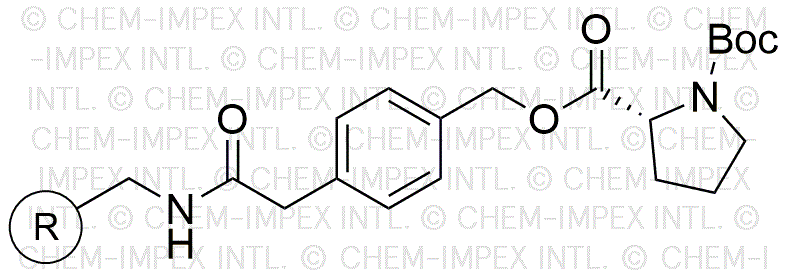Boc-D-proline 4-oxymethylphenylacetamidomethyl is widely utilized in research focused on:
- Peptide Synthesis: This compound serves as a key building block in the synthesis of peptides, particularly in the development of peptide-based drugs and therapeutics.
- Drug Development: Its structural properties make it valuable in the design of novel pharmaceutical agents, especially in targeting specific biological pathways.
- Bioconjugation: The compound is used in bioconjugation techniques, allowing researchers to attach biomolecules to surfaces or other molecules, enhancing drug delivery systems.
- Research in Neuroscience: It plays a role in studying neurological pathways due to its ability to mimic natural amino acids, aiding in the understanding of brain function and disorders.
- Material Science: The compound is also explored in the development of new materials, particularly those that require specific functional groups for enhanced performance in various applications.
General Information
Properties
Safety and Regulations
Applications
Boc-D-proline 4-oxymethylphenylacetamidomethyl is widely utilized in research focused on:
- Peptide Synthesis: This compound serves as a key building block in the synthesis of peptides, particularly in the development of peptide-based drugs and therapeutics.
- Drug Development: Its structural properties make it valuable in the design of novel pharmaceutical agents, especially in targeting specific biological pathways.
- Bioconjugation: The compound is used in bioconjugation techniques, allowing researchers to attach biomolecules to surfaces or other molecules, enhancing drug delivery systems.
- Research in Neuroscience: It plays a role in studying neurological pathways due to its ability to mimic natural amino acids, aiding in the understanding of brain function and disorders.
- Material Science: The compound is also explored in the development of new materials, particularly those that require specific functional groups for enhanced performance in various applications.
Documents
Safety Data Sheets (SDS)
The SDS provides comprehensive safety information on handling, storage, and disposal of the product.
Product Specification (PS)
The PS provides a comprehensive breakdown of the product’s properties, including chemical composition, physical state, purity, and storage requirements. It also details acceptable quality ranges and the product's intended applications.
Certificates of Analysis (COA)
Search for Certificates of Analysis (COA) by entering the products Lot Number. Lot and Batch Numbers can be found on a product’s label following the words ‘Lot’ or ‘Batch’.
Número de catálogo
Número de lote/lote
Certificates Of Origin (COO)
This COO confirms the country where the product was manufactured, and also details the materials and components used in it and whether it is derived from natural, synthetic, or other specific sources. This certificate may be required for customs, trade, and regulatory compliance.
Número de catálogo
Número de lote/lote
Safety Data Sheets (SDS)
The SDS provides comprehensive safety information on handling, storage, and disposal of the product.
DownloadProduct Specification (PS)
The PS provides a comprehensive breakdown of the product’s properties, including chemical composition, physical state, purity, and storage requirements. It also details acceptable quality ranges and the product's intended applications.
DownloadCertificates of Analysis (COA)
Search for Certificates of Analysis (COA) by entering the products Lot Number. Lot and Batch Numbers can be found on a product’s label following the words ‘Lot’ or ‘Batch’.
Número de catálogo
Número de lote/lote
Certificates Of Origin (COO)
This COO confirms the country where the product was manufactured, and also details the materials and components used in it and whether it is derived from natural, synthetic, or other specific sources. This certificate may be required for customs, trade, and regulatory compliance.

